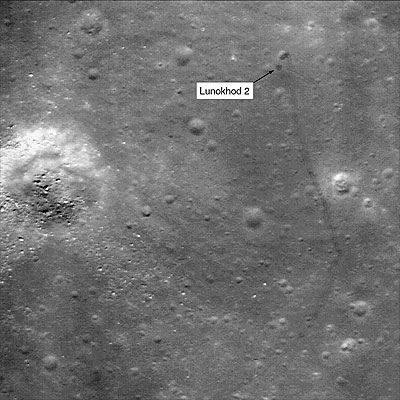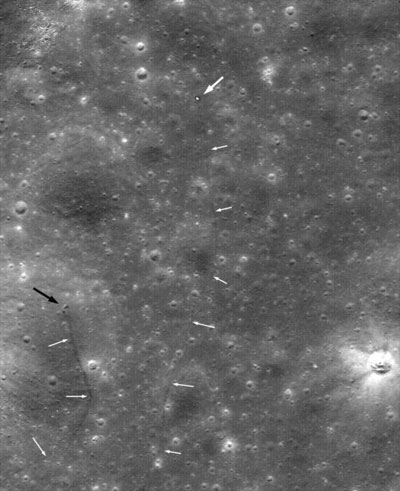|
|

|
|
Author
|
Topic: Soviet Lunokhod rovers located on the Moon
|
Robert Pearlman
Editor Posts: 42988
From: Houston, TX
Registered: Nov 1999
|
 posted 03-16-2010 09:39 PM
posted 03-16-2010 09:39 PM
   
University of Western Ontario release Western researcher solves 37-year old space mysteryA researcher from The University of Western Ontario has helped solve a 37-year old space mystery using lunar images released yesterday by NASA and maps from his own atlas of the moon. Phil Stooke, a professor cross appointed to Western's Departments of Physics & Astronomy and Geography, published a major reference book on lunar exploration in 2007 entitled, "The International Atlas of Lunar Exploration." Yesterday, images and data from NASA's Lunar Reconnaissance Orbiter (LRO) were posted. The LRO, scheduled for a one year exploration mission about 31 miles above the lunar surface, will produce a comprehensive map, search for resources and potential safe landing sites and measure lunar temperatures and radiation levels. Using his atlas and the NASA images, Stooke pinpointed the exact location of the Russian rover Lunokhod 2, discovering tracks left by the lunar sampler 37 years ago after it made a 35-kilometre trek. The journey was the longest any robotic rover has ever been driven on another celestial body. 
Credit: UWO/NASAAs soon as the NASA photos were released, scientists around the world, including Stooke, began work to locate the rover. Stooke set up a searchable image database and located the photograph he needed, among thousands of others. "The tracks were visible at once," says Stooke. "Knowing the history of the mission, it's possible to trace the rover's activities in fine detail. We can see where it measured the magnetic field, driving back and forth over the same route to improve the data. And we can also see where it drove into a small crater, and accidentally covered its heat radiator with soil as it struggled to get out again. That ultimately caused it to overheat and stop working. And the rover itself shows up as a dark spot right where it stopped." The find, he adds will mean that older maps published by Russia will now need to be revised.
Stooke says that NASA scientists have used his atlas in both preparation and data recovery. His next project is a similar volume on Mars exploration which will include the best maps of the moons of Mars. Stooke is also a member of Western's Centre for Planetary Science and Exploration (CPSX). CPSX represents the largest concentration of planetary scientists in Canada and has resulted in Western becoming the epicentre for planetary science and exploration in the country - particularly for graduate students. |
Robert Pearlman
Editor Posts: 42988
From: Houston, TX
Registered: Nov 1999
|
 posted 03-17-2010 12:59 PM
posted 03-17-2010 12:59 PM
   
Turns out Phil Stooke mistook a crater for Lunokhod 2, but Sasha Basilevsky found the real rover, as related by Emily Lakdawalla with The Planetary Society. There's an interesting story in the discovery of Lunokhod 2 in this image. Yesterday, planetary cartographer Phil Stooke posted an item to unmannedspaceflight.com pointing out what he thought was the final location, a dark patch of pixels on the image above, near the black arrow. But this morning, I had an email in my inbox from Sasha Basilevsky, addressed to Phil, titled "Close, but not the place." Sasha wrote: "I think you indicated not the Lunokhod 2 but the crater in which Lunokhod [accidentally] got in and, maneuvering in which, it put soil on the solar battery panel. That later resulted in pollution of thermal radiator with that soil and overheating and death of Lunokhod 2 next day. Look at the attached image. The position of Lunokhod 2 (big white arrow) was determined by Sergei Gerasimenko, Kharkov University. Black arrow shows that damned crater. Small white arrows show the Lunokhod tracks." 
Credit: NASA/GSFC/ASU/Sergei Gerasimenko/Sasha Basilevsky |
Robert Pearlman
Editor Posts: 42988
From: Houston, TX
Registered: Nov 1999
|
 posted 03-17-2010 08:15 PM
posted 03-17-2010 08:15 PM
   
Computer game pioneer and Soyuz TMA-13 crew member Richard Garriott has responded to the reports of his lunar rover being found.National Public Radio (NPR): After 37 Years, Owner Locates Lost Moon Rover "I am the world's only private owner of an object on a celestial body," he says.The object he's referring to is the Lunokhod 2 rover. The Lunokhod 2 is a Russian space vehicle that landed on the moon in 1973 -- and stopped working that same year. Even though no one knew exactly where the rover was, it went up for sale at a 1993 Sotheby's auction in New York, and Garriott handed over $68,500 for it. Last Monday, scientists spotted the Lunokhod 2 rover for the first time in 37 years. "As soon as I saw this new data, I did a recheck of the findings, and there's no question that they have the right target. It's my Lunokhod 2," Garriott says. Garriott says he's thrilled to finally have photos of his "private flag sitting on the moon." Meanwhile, Sasha Basilevsky has now also located Lunokhod 1 in LRO's images. |
Robert Pearlman
Editor Posts: 42988
From: Houston, TX
Registered: Nov 1999
|
 posted 04-27-2010 07:35 AM
posted 04-27-2010 07:35 AM
   
NASA release NASA's LRO Team Helps Track Laser Signals to Russian Rover MirrorUsing information provided by NASA's Lunar Reconnaissance Orbiter (LRO) instrument teams, researchers at the University of California San Diego have successfully pinpointed the location of a long lost light reflector left on the lunar surface by bouncing laser signals from Earth to the Russian Lunokhod 1 retroreflector. The initial imaging of the two Russian rovers, Lunokhod 1 and 2 were made earlier this year by the Lunar Reconnaissance Orbiter Camera (LROC) team, led by Mark Robinson from Arizona State University in Tempe. On April 22, Tom Murphy from the University of California San Diego and his team sent pulses of laser light from the 3.5 meter telescope at the Apache Point Observatory in New Mexico, zeroing in on the target coordinates provided by the LROC images and altitudes provided by the Lunar Orbiter Laser Altimeter. "We quickly verified the signal to be real and found it to be surprisingly bright: at least five times brighter than the other Soviet reflector, on the Lunokhod 2 rover, to which we routinely send laser pulses," said Tom Murphy, an associate professor of physics at the University of California San Diego. "The best signal we've seen from Lunokhod 2 in several years of effort is 750 return photons, but we got about 2,000 photons from Lunokhod 1 on our first try. It's got a lot to say after almost 40 years of silence." Since Apollo deployed laser retroreflectors, astronomers have routinely used them to track how the moon is slowly moving away from the Earth. This helps scientists develop a better understanding of the processes that are causing this motion, including what's occurring inside the moon's core and the tidal motions on the Earth. The Lunokhod 1 retroreflector was sent aboard the unmanned Luna 17 mission, which landed on the moon November 17, 1970, releasing a robotic rover that roamed the lunar surface. Murphy said his team had occasionally looked for the Lunokhod 1 retroreflector over the last two years, but had little chance of finding it until the LRO team produced coordinates based on the recent images of the lander and rover that were good to within 100 meters. "It turns out that our previous best-guess position was miles off," he said. "We could only search one football-field-sized region at a time, so without LRO, we never would have found it. But with the new coordinates, we found the signal promptly at the very edge of our available window." Locating Lunokhod 1 and measuring its exact coordinates is important in furthering our understanding of the moon. "Getting more than a few photons back from an unknown location at the distance of the moon is quite an achievement. The rediscovery of the Lunokhod-1 retroreflector was made possible by the LRO camera team and by the diligence of Tom Murphy," said Gregory Neumann, Lunar Orbiter Laser Altimeter team member from NASA Goddard Space Flight Center in Greenbelt, Md. "That we have located it so quickly and ranged to the Lunokhod rover, last heard from September 14, 1971, is a tribute to Tom's team and to the amazing LRO observatory and instrument teams." | |
Contact Us | The Source for Space History & Artifacts
Copyright 2020 collectSPACE.com All rights reserved.

Ultimate Bulletin Board 5.47a
|
|

|
 advertisement advertisement

|













